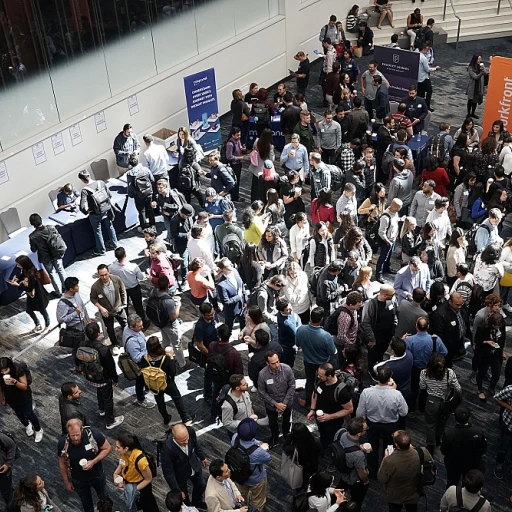
The Role of AI in Modern Communication Tools
AI as a Catalyst for Modern Communication Efficiency
In the rapidly evolving landscape of workplace communication, artificial intelligence is becoming a pivotal element. Companies are constantly on the lookout for internal communication tools that boost efficiency and foster effective collaboration among teams. AI-driven communication platforms are stepping up to this challenge, offering features that weren't possible before.
These AI-powered tools utilize machine learning algorithms to streamline communication processes. From automating routine tasks like sorting emails and scheduling meetings to enhancing employee engagement through tailored content, AI plays a crucial role in reducing the time teams spend on administrative duties. This focus on automation not only enhances productivity but also encourages employees to focus on more strategic tasks that require human creativity and problem-solving ability.
AI's integration into communication software is also revolutionizing employee experience by facilitating real-time interaction and collaboration, regardless of geographical barriers. Tools such as Microsoft Teams, Google Workspace, and other communication platforms incorporate AI to support video conferencing, instant messaging, and project management. These features ensure seamless communication among team members, improving overall employee communication and collaboration.
Moreover, AI-driven communication platforms offer predictive analytics that provide insights into team performance and employee engagement levels. Such insights are vital for management to craft effective communication strategies in the increasingly common hybrid work models. For more on crafting effective communication strategies, visit this resource.
Benefits of AI-Driven Communication Platforms
Enhanced Employee Engagement and Collaboration
AI-driven communication platforms offer numerous benefits, especially when it comes to improving employee engagement and collaboration within organizations. Through sophisticated algorithms, these platforms facilitate effective internal communication by streamlining the flow of information among team members. This is achieved by integrating multiple communication tools such as email, instant messaging, and video conferencing into one cohesive platform. AI-enhanced communication software allows for real-time interactions that are both efficient and accessible. By offering key features like real-time file sharing and collaborative project management tools, these platforms ensure that employees remain connected, regardless of their physical location. This integration is crucial for companies seeking to foster an inclusive work environment, enabling remote employees to engage and participate as actively as those in-office. Moreover, advanced AI-powered platforms support employee communication through intelligent systems that can analyze communications data and suggest improvements. For instance, by leveraging natural language processing, these tools can provide insights into employee engagement levels during meetings and suggest ways to enhance productivity. This feature is particularly beneficial for management teams looking to optimize internal communications strategies. Loneliness and disconnection among employees can be mitigated by using these advanced AI communication software. Variable formats like audio, video, and text can cater to different communication preferences, enhancing the overall employee experience. As these platforms continue to evolve, their ability to facilitate seamless internal communications will only improve, leading to an engaged and cooperative workforce. HR professionals can explore the modern approach to enhancing employee feedback with AI for more insights into how AI can influence communication strategies, thereby creating a more dynamic workplace environment.Challenges in Implementing AI in Communication
Overcoming Challenges in the Integration of AI for Communication
Adopting AI in workplace communication presents undeniable potential, but it's met with unique hurdles. To effectively integrate AI communication software into a company's framework, several key challenges need to be addressed. One major issue revolves around the readiness of employees. The shift to superior AI-driven communication platforms requires a cultural adjustment and adequate training. Employees might initially resist changing established communication dynamics or feel overwhelmed by advanced features introduced by modern tools such as video conferencing, file sharing, and project management solutions. Moreover, the fear of data privacy and security breaches is an overarching concern for management. As internal communications are increasingly operated through AI-based communication tools, safeguarding sensitive information becomes a critical priority. Companies must ensure robust protection strategies and compliance with data regulations to build trust and transparency among their employees and teams. Integration with existing systems poses another layered challenge. Many workplaces employ a variety of communication tools like Microsoft Teams or Google Workspace, which their teams are accustomed to. Seamless integration with these platforms ensures that employee engagement does not falter due to compatibility issues. Additionally, while AI platforms aim to enhance real-time employee communication, the balance between automation and human touch in employee experience remains a delicate one to maintain. Automated responses and predictive texting can streamline certain communications but may inadvertently lead to a decrease in human engagement over time. Understanding these challenges is essential. Organizations should focus on enhancing the onboarding process, prioritizing employee training, and continuously monitoring the communication platforms for feedback and effectiveness. For further insights, consider exploring engaging office activities to boost employee morale, which can further enhance the adoption process by promoting a supportive workplace atmosphere.Case Studies: Successful AI Integration in Communication
Real-life Examples of AI-Enhanced Communication
Implementing AI-powered platforms in businesses has seen varying degrees of success. Case studies highlight the tangible improvements in internal communications driven by AI integration. One such example is from a multinational corporation that overhauled its employee communication approach with AI. By adopting cutting-edge communication software, the company improved employee engagement through better-targeted content and more responsive communication tools. Key features such as instant messaging, real-time video conferencing, and AI-enhanced file sharing streamlined interactions, promoting efficient communication between team members across the globe. Another success story involves a tech startup that integrated AI-powered tools into their internal communication strategy. With communication platforms like Microsoft Teams, the startup enhanced collaboration within its distributed teams. This approach allowed for seamless project management and improved internal communications, which in turn boosted productivity and employee experience significantly. The tool also offered AI-driven insights into communication trends and team members’ engagement, helping the company fine-tune their strategies for better outcomes. Large enterprises have also tapped into AI to transform their communication software by incorporating platforms like Google Workspace. AI tools have been leveraged to automate routine communications, manage calendars efficiently, and assist in project collaboration. This not only helped reduce the time spent on mundane tasks but also ensured more time for strategic initiatives, leading to increased employee satisfaction. These case studies reflect the capacity of AI to elevate employee communications, prove the effectiveness of AI-driven communication platforms, and pave the way for future integration in modern workplaces.Future Trends in AI and Internal Communication
Emerging Innovations in AI-Driven Employee Engagement
The landscape of internal communication is continuously evolving with the advent of AI technologies. These innovations are not only enhancing the way teams collaborate but are also providing unprecedented features in communication platforms. As companies strive for improved employee engagement, AI-driven communication platforms are poised to revolutionize internal communications. One of the most promising trends is the integration of real-time communication software across diverse platforms. Tools such as video conferencing, instant messaging, and file sharing are becoming more seamless, aiding in quick and effective communication between team members. This shift ensures that employees can collaborate more efficiently, improving overall employee experience. Platforms like Google Workspace and Microsoft Teams are leading the charge by offering enhanced collaboration tools that allow for easier project management and content sharing among employees. These tools incorporate AI-powered features like automated scheduling and meeting summaries, which save time and streamline communications across departments. Moreover, adaptive communication platforms are beginning to employ machine learning algorithms to analyze communication patterns and suggest optimal engagement strategies. This proactive approach to employee communication can help identify potential bottlenecks and ensure that management can address them swiftly. As AI technology continues to develop, we can anticipate the emergence of more sophisticated capabilities within internal communications. These advancements will likely focus on refining communication tools that foster an inclusive environment for all employees, regardless of their preferred communication style or geographic location. By staying attuned to these trends, companies can effectively harness AI to foster a more connected and engaged workforce.Best Practices for Choosing AI Communication Tools
Guidelines for Selecting Effective AI Communication Platforms
Selecting the best internal communication tools is vital for enhancing employee engagement and ensuring smooth collaboration among team members. It requires careful evaluation and comprehensive understanding of your organization's needs. Here’s a concise guideline to help you in making an informed decision:- Identify Your Communication Needs: Assess whether your organization prioritizes instant messaging, video conferencing, file sharing, or project management features. This step will guide you toward platforms tailored to your requirements.
- Evaluate Key Features: Focus on platforms that offer robust key features such as real-time collaboration, seamless integration with existing systems like Microsoft Teams or Google Workspace, and scalable solutions to cater to growing teams.
- Consider User-Friendliness: User experience is crucial, as complicated interfaces may discourage employee engagement. Opt for communication software that ensures ease of use and quick onboarding for all employees.
- Assess Security and Compliance: In an era of increasing data breaches, selecting communication platforms with strong security protocols and compliance with legal standards is imperative to protect sensitive information.
- Seek Vendor Support and Training: Ensure the tool provides excellent customer support and training opportunities to facilitate smooth integration into your current workflow.
- Review Success Stories: Look into case studies from companies with similar workflow patterns that have successfully integrated AI-driven communication tools to boost employee experience and productivity.
- Test Before Committing: Engage in trials or pilot programs to test the platform in your unique environment, measure its impact on communication and employee engagement before fully committing.












